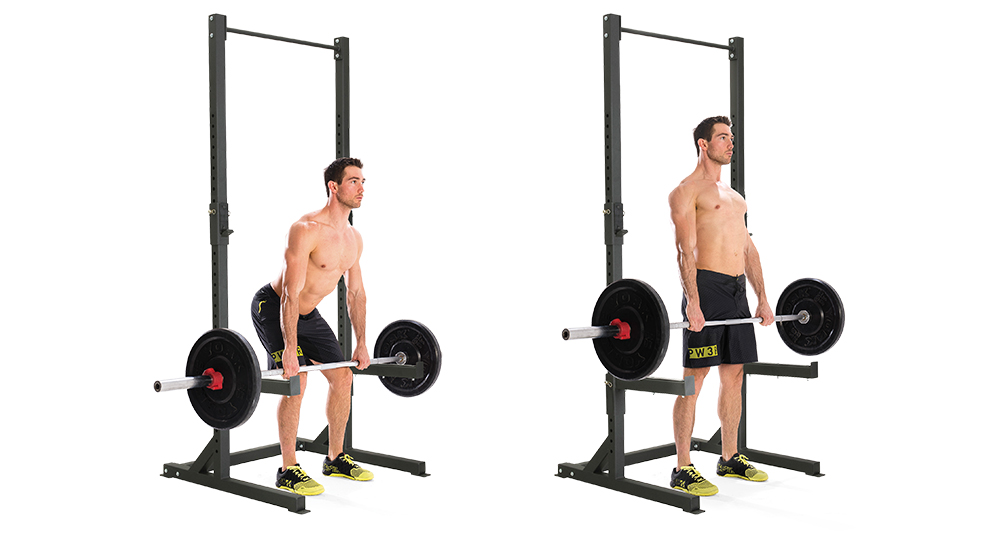How To Do The Rack Pull
Bulk up your back and improve your deadlift numbers with this barbell exercise

It’s easy to dismiss rack pulls as a poor man’s deadlift, but there’s more to this barbell exercise than meets the eye. It allows you to tackle heavier weights by shortening the range of motion, which can result in stronger back muscles, as well as improved form and power in the top half of your deadlift.
To familiarise you with the ins and outs of this deadlift variation, we went to NSCA-accredited strength and conditioning coach Andrew Reay, who spoke to us on behalf of sports coach booking platform Sport Session.
What muscles do rack pulls work?
“The whole back side of your body, or posterior chain, will be worked,” says Reay. “It’s a heavy lift so there will be a lot of work through the glutes, lower back and the upper back, if you set up correctly, and to a lesser extent your calves and hamstrings.
“You’re likely to get a little more glute work from a rack pull than a deadlift due to the fact that you can lift a bit heavier, and the range of motion means the glutes do a lot of work. The glutes are big, powerful muscles and they respond well to a heavy load, so if you can lift slightly heavier then you’ll get slightly more glute activation.”
Benefits Of The Rack Pull
Rack pulls offer several benefits that may persuade you to include them in your training.
Improving your deadlift: “I see rack pulls as a way to improve your deadlift,” says Reay. “If you’re weak during the upper portion of the lift then it should allow you to lift heavier, so if you spend a block of time building strength with rack pulls then you can go back and see if your deadlift has improved.”
Posterior chain development: “Many people will do a lot of squatting and bench pressing,” says Reay, “but I think many programmes lack focus on the posterior chain. These are the muscles we use to propel us forwards, in sport and in everyday life, so we don’t want to miss training them! The rack pull can put a lot of load through the posterior chain, helping to build some serious strength.”
Developing strength: There are few movements that allow you to lift as heavy as the rack pull, including the deadlift. As a result, this is a great exercise for building strength by progressively overloading your glutes and back muscles.
How To Do The Rack Pull
Set up a barbell on a power rack so it’s resting on either a set of hooks or spotter arms an inch or two above knee height. “You should always start with a slight bend in your knees,” says Reay. “A helpful cue is to have the bar almost directly under your shoulders. If you can get into that position, your back should be straight.”
Get the Coach Newsletter
Sign up for workout ideas, training advice, reviews of the latest gear and more.
Another top tip Reay suggests to ensure good form is to imagine you’re “crushing oranges under your armpits”. This will keep your arms tucked tight to the sides of your body.
Take a deep breath in, brace your core and then lift the bar by driving your hips forwards and straightening your knees. Keep the bar close to your legs as you stand up straight. Control the descent to return to the start position.
When should you do rack pulls?
Given the wide variety of muscles worked, it can be hard to place rack pulls into your existing programme. After all, if you’re following a push/pull/legs split, which day does it fit into when both your back and leg muscles are being put to work?
“For me, it would fit into a leg day,” says Reay. “You might also try and fit it into what I would call a ‘hinge’ day, with movements like the deadlift and Romanian deadlift.”
Rack Pull Variations
Resistance band rack pull
An easy way to increase the challenge of your rack pulls is to attach resistance bands to the rack’s feet and both ends of the bar. This will increase the overall resistance in the exercise and also progressively load that resistance to the top of the move, when the tension in the band is the greatest. If you’re doing rack pulls to improve the top half of your deadlifts, this is a canny way to make the exercise even more effective in that regard.
Trap bar deadlift
This variation on the standard deadlift eases the pressure on your back during the lift, making it a great option for those new to the exercise. Between rack pulls and the trap bar deadlift you’ll build all the strength required to nail full deadlifts and strengthen your back safely. The hexagonal or diamond-shaped trap bar is designed so you can stand inside it and hold the handles by your sides as you perform the lift, rather than leaning over to grab a standard barbell from the ground in front of you.
Stand in the middle of the bar and reach down to grab the handles. Sit your hips back, raise your torso and look up in front of you. Stand up by straightening your hips and knees, keeping your back flat. Lower the bar slowly back to the start.

Harry covers news, reviews and features for Coach, Fit&Well and Live Science. With over a decade of training experience, he has tried everything from powerlifting to gymnastics, cardio to CrossFit, all in a bid to find fun ways of building a healthy, functional body.
- Nick Harris-FrySenior writer









